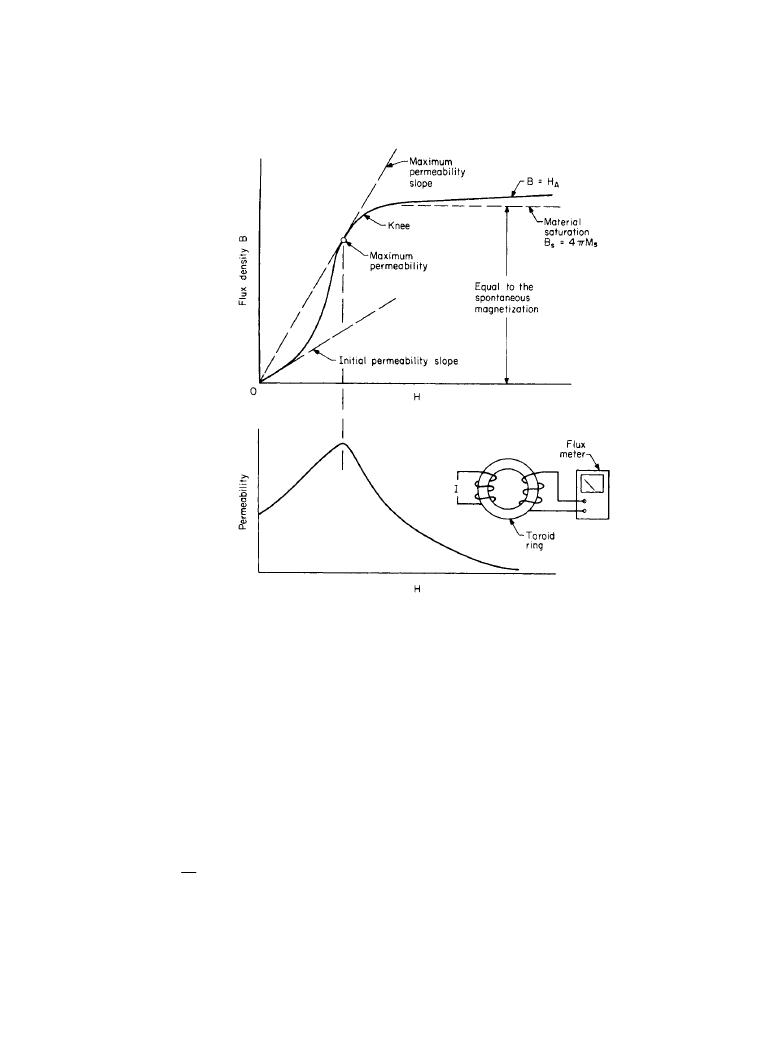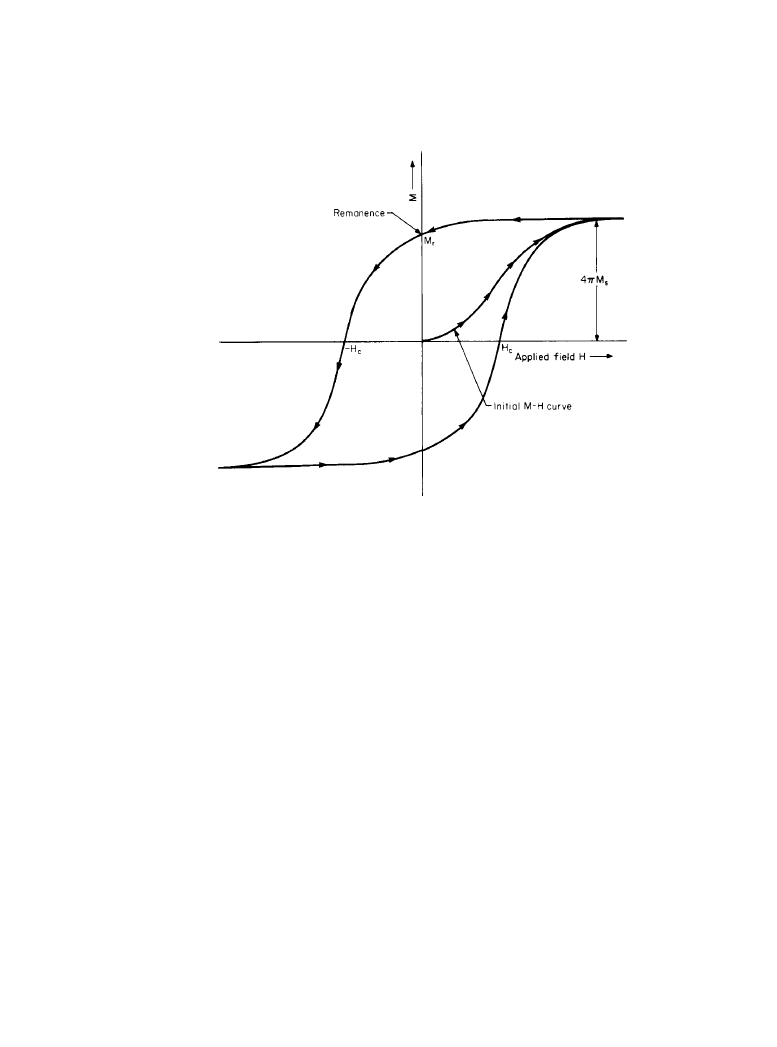ВУЗ: Казахская Национальная Академия Искусств им. Т. Жургенова
Категория: Книга
Дисциплина: Не указана
Добавлен: 03.02.2019
Просмотров: 21719
Скачиваний: 19

9-32 Audio Recording Systems
Initial Magnetization B-H Curve
The relationship of the induced flux density B and the net field H of soft magnetic material is
typically described by the initial B-H magnetization curves and the B-H hysteresis loop.
Figure 9.2.4a shows the initial magnetization curve of a typical soft magnetic material. This
curve is obtained by starting with a toroid ring in the demagnetized state and plotting the flux
density B against the field H. The demagnetization field in a toroid ring is zero; the net field is
therefore equal to the applied field. The slope of the initial magnetization curve is the permeabil-
ity
µ, defined by:
(9.2.3)
B
H
µ
=
(
a)
(
b)
Figure 9.2.4
Permeability effects: (
a) initial B-H curve, (b) permeability versus H field.
Downloaded from Digital Engineering Library @ McGraw-Hill (www.digitalengineeringlibrary.com)
Copyright © 2004 The McGraw-Hill Companies. All rights reserved.
Any use is subject to the Terms of Use as given at the website.
Properties of Magnetic Materials

Properties of Magnetic Materials 9-33
In CGS units, the permeability is a dimensionless ratio and represents the increase in flux
density relative to air caused by the presence of the magnetic material. The permeability can also
be defined in terms of the magnetization M as:
(9.2.4)
Starting at the origin, the curve has a finite slope which is the initial permeability. As the field
H is increased, the slope becomes steeper. This is the maximum permeability region. The value
of the maximum permeability is determined with a straight line of the steepest slope that passes
through the origin and also contacts the magnetization curve. Finally, as H is further increased, a
point is reached on the initial B-H curve where the magnetization approaches a finite limit indi-
cated by the dotted line. At this point, the magnetization of the material does not increase with
further increases in the field, This is the saturation flux density B, which is equal to the spontane-
ous magnetization of the magnetic material. After the material has reached saturation, the slope
of the B-H curve changes and the flux density B continues to rise indefinitely at the rate of B =
H
A
as if the magnetic material were not present. Figure 9.2.4b shows a plot of the permeability as
a function of the field.
9.2.2c
Hysteresis Loop
If the H field is decreased after the initial magnetization curve reaches the saturated state, it is
found that the induction does not follow the same initial curve back to the origin but traces a
curve called the hysteresis loop, shown by Figure 9.2.5. As the magnetization is gradually
decreased from the saturation point C, it follows along the lines CD and reaches a finite value B
r
(the remanence), which is the flux density remaining after removal of the applied field. In order
to reduce the remanence to zero, a negative field—the coercive force H
c
.—must be applied. The
curve from D to E is the demagnetization curve. As H is further increased in the negative direc-
tion, the magnetization will proceed from E to F, and the material will eventually become satu-
rated in the opposite direction. If at this point the field is again reversed to the positive direction,
the magnetization will trace the line F, G, C and the hysteresis loop is completed.
Hysteresis Losses
The area of the hysteresis loop is the energy necessary to magnetize a magnetic substance. This
energy is expended as heat. The loop area is a measure of the heat energy expended per cycle, per
unit volume, and is called the hysteresis loss:
ergs/(cm
3
⋅ cycle)
(9.2.5)
A practical expression for power loss P in watts is given by:
(9.2.6)
4
1
M
H
π
µ
= +
4
h
A
W
π
=
7
10
4
f a l
P
A
π
−
=
× ×
Downloaded from Digital Engineering Library @ McGraw-Hill (www.digitalengineeringlibrary.com)
Copyright © 2004 The McGraw-Hill Companies. All rights reserved.
Any use is subject to the Terms of Use as given at the website.
Properties of Magnetic Materials

9-34 Audio Recording Systems
Where:
A = area of the loop, gauss-oersteds
f = frequency, Hz
a = cross-sectional area of core, cm
2
l = magnetic path length, cm
Figure 9.2.5 shows a comparison between the hysteresis loops for hard and soft magnetic
materials. As indicated by the difference in the areas of the loops, more energy is required to
magnetize the hard magnetic materials.
Initial M-H Curve and M-H Hysteresis Loop
The initial M-H curve and M-H hysteresis loops are plots of the magnetization M versus the net
field H and are typically used to describe the intrinsic properties of hard magnetic materials such
as those used in recording media. An initial M-H curve is shown in Figure 9.2.6. The slope of the
M-R curve is the susceptibility x and is defined by:
Figure 9.2.5
B-H loops for hard and soft materials.
Downloaded from Digital Engineering Library @ McGraw-Hill (www.digitalengineeringlibrary.com)
Copyright © 2004 The McGraw-Hill Companies. All rights reserved.
Any use is subject to the Terms of Use as given at the website.
Properties of Magnetic Materials

Properties of Magnetic Materials 9-35
(9.2.7)
The permeability may be related to the susceptibility by:
(9.2.8)
When the saturation magnetization M
s
is reached, the M-H curve approaches a finite limit and
does not increase indefinitely as in the case of the B-H curve.
If, at the saturation point of the initial M-H curve, the applied field is made to follow the same
sequence as previously outlined for the B-H loop, an M-H hysteresis loop will be traced (see Fig-
ure 9.2.7).
The ratio of the rernanent magnetization M
r
to the saturation magnetization M
s
is called the
squareness ratio and is an important parameter in evaluating the magnetic orientation of the par-
ticles in magnetic tape. The squareness ratio is 1.0 for perfectly oriented particles. More practical
values for oriented particles range from 0.7 to 0.9. Randomly oriented particles are approxi-
mately 0.5.
9.2.2d
Demagnetization
If a short bar of magnetic material is magnetized by an applied field H, poles are created at each
end. These poles in turn create a magnetic field in the opposite direction to the applied field.
M
x
H
=
1 4 x
µ
π
= +
Figure 9.2.6
Initial
M-H curve.
Downloaded from Digital Engineering Library @ McGraw-Hill (www.digitalengineeringlibrary.com)
Copyright © 2004 The McGraw-Hill Companies. All rights reserved.
Any use is subject to the Terms of Use as given at the website.
Properties of Magnetic Materials

9-36 Audio Recording Systems
This opposition field is called the demagnetizations field H
d
(see Figure 9.2.8). The net field H
acting on the bar is:
(9.2.9)
The demagnetizing field H
d
is dependent on the shape of the magnetic object and the magne-
tization M [1, 3].
The demagnetization field is zero in a ring core with no air gap. However, when an air gap is
cut, creating poles at the gap-confronting surfaces, the resulting demagnetization field shears the
hysteresis loop from the original position. This effect is shown by Figure 9.2.9.
To bring a magnetic substance to a demagnetized state, a field that is equal to the coercive
force H
c
must be applied. However, upon removal of this field, the residual flux density will rise
to a value B
1
, as illustrated by Figure 9.2.10. It is possible to reduce this residual flux density to
zero by increasing demagnetization field to a value greater than H
c
and then decreasing it to zero
as shown by the dashed lines. This technique requires knowledge of the magnetic history of the
material.
A more effective method to completely demagnetize a magnetic material is demagnetization
by reversals. In this method, the material is first saturated by an ac field, then cycled through a
series of diminishing field reversals as shown by Figure 9.2.11. The magnetic material will be
left in a demagnetize state when zero field is reached regardless its magnetic history. This tech-
A
d
H
H
H
=
−
Figure 9.2.7
M-H hysteresis loop.
Downloaded from Digital Engineering Library @ McGraw-Hill (www.digitalengineeringlibrary.com)
Copyright © 2004 The McGraw-Hill Companies. All rights reserved.
Any use is subject to the Terms of Use as given at the website.
Properties of Magnetic Materials